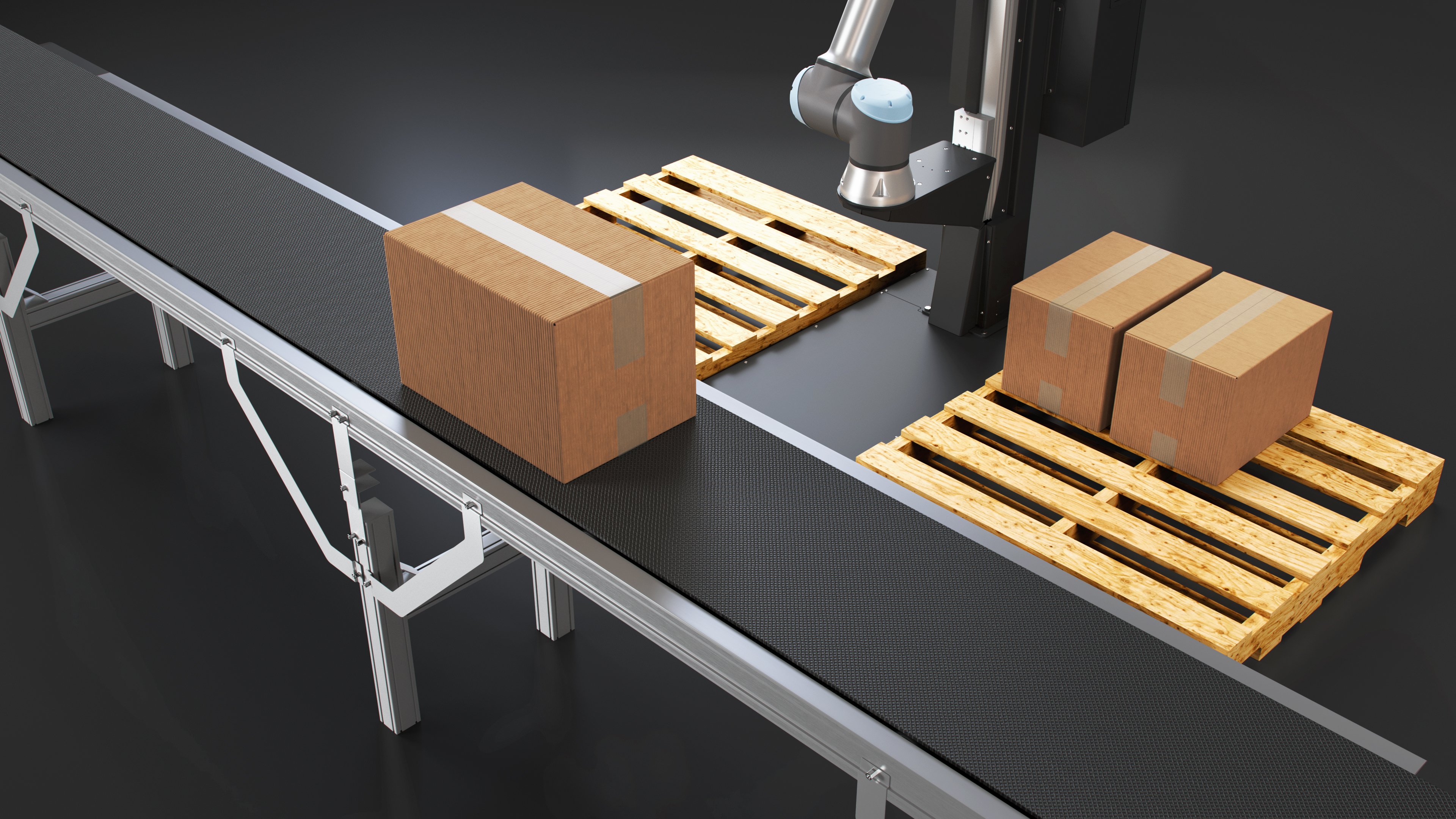Pallet conveyors are a fundamental component in material handling and end of line operations. Choosing the right conveyor can have a direct impact on shipping times, facility layout, and overall productivity.
The right pallet conveyor can reduce wasteful manual labor steps, optimize your space, and even open the doors to automated palletizing solutions. However, the wrong choice could lead to higher costs, wasteful inefficiencies, and inventory bottlenecks .
To help you avoid these pitfalls, this guide walks you through the 10 essential steps for picking the right conveyor for your palletizing.
Laying the Groundwork for an Improved Palletizing Process
Selecting the right conveyor is more than just a practical purchasing decision. It can be a strategic move to enhance your material handling process.
If you are using manual palletizing — where workers stack pallets with products — the right conveyor can help to reduce dangerous ergonomic issues that can lead to physical injury and even impact employee mental health.
Ryan Weaver, VP of Commercial at Robotiq, explains:
“Palletizing is one of the most labor-intensive tasks in the production and shipping process. The high risk of injury from repeatedly picking and stacking heavy boxes makes it a risk for the company. Additionally, the dull and repetitive nature of the task means it’s hard to find and retain workers willing to do the job.”
If you are using automated palletizing, there are many extra benefits. The right conveyor can help to optimize your automated process to create a seamless, efficient workflow. When combined with robotic palletizing, the conveyor forms a system that helps reduce common pallet problems like loading inefficiency, misalignment, product damage, and inconsistent pallet quality.
Whether you are using manual or automated palletizing, the conveyor lays the groundwork for an efficient and scalable palletizing process.
10 Steps to Choose the Right Pallet Conveyor
Choosing your ideal pallet conveyor requires a clear understanding of your operational needs, future goals, and constraints that affect the deployment.
Here are 10 steps to help you clarify which pallet conveyor will meet both your current and future vision for your end of line:
Step 1: Decide on Automated or Manual Palletizing
First, you must decide if you will use a manual palletizing process or an automated one. This can radically affect the choice of conveyor. If you haven’t considered automating your palletizing process before, now is a good time to think about it.
Manual palletizing is a viable option for small-scale operations with infrequent packaging demands or budget constraints. In this case, you will look for conveyors that enhance manual palletizing.
Automated palletizing offers significant advantages, including better packing consistency, enhanced workplace safety, and room for scalable growth. Robotic palletizing has become a strong strategic move for many companies in the last 5 years.
Step 2: Map Your Existing Process First
Before selecting a conveyor, take time to map out your current manual process. This is a key step in the Lean Robotics Framework that we always suggest before people add new technology.
Robotiq’s Application Expert Marc-Antoine Lacasse explains the importance of this step in our free palletizing eLearning course:
“Manual task mapping is the first step to really understand the application well. Ask questions like: What is the next step in the production line? How does the pallet leave the cell? Take the time to complete the entire process and note which tasks were value-added and which were downtimes.”
To help with this, download our free manual task map template.
Step 3: Decide on Centralized or Decentralized Palletizing
You should then take a step back and look at how your palletizing cell fits in the overall flow of your entire facility. Specifically, decide if you are using centralized or decentralized palletizing.
Centralized palletizing involves gathering all product lines into a single location. This can be an efficient approach for high-volumes and can minimize the floor space required for your palletizing cell. However, it might require a more complex network of conveyors if you have a lot of product lines.
Decentralized palletizing deploys smaller, independent palletizing stations for processing single or small numbers of product lines. This can allow for greater flexibility but may require a larger investment upfront.
Step 4: Define the Conveyor’s Role
To choose the right pallet conveyor, start by defining its specific purpose. This should be fairly straightforward after going through the previous steps.
Ask questions like:
- Will the conveyor transport loose products, pallets, or both?
- If transporting products, will they be packaged or unpackaged?
- If transporting pallets, what properties of the pallets themselves might influence the type of conveyor?
Each pallet type has unique characteristics that can affect your choice of conveyor. For example, pallets with formed feet can enhance the stability and longevity of storage, and are well suited to drag train conveyors.
Step 5: Clarify the Operational Properties of Your Conveyor
There is a staggering number of conveyor types. Before even looking at the individual types, it’s helpful to clarify exactly what operational properties you need from your conveyor.
For example:
- Load capacity — How heavy are the pallets or items that the conveyor will transport?
- Environment — Is the environment dirty or involve high or low temperatures?
- Loading and unloading procedures — How will items be loaded onto the conveyor and unloaded at their destination?**
- Conveyor speed — How quickly do items need to move to keep the correct cadence within your product workflow?
- Object properties — What properties of the products themselves might affect conveyor choice? For example, are items delicate, heavy, or require special treatment.
The decisions you make now will help you narrow down the options.
Step 6: Pick the Suitable Type of Conveyor
Now, it’s time to look at the different types of conveyor and compare them against the needs of your application.
Some of the many conveyor types include:
- Chain driven conveyors — These are driven by chains and are ideal for tough, dirty environments and high-load pallets.
- Drag chain conveyors — Instead of pulling with a chain, these pull the load. They are relatively compact and work well in high-temperature environments.
- Plastic belt powered conveyors — These are ideal for loads that can’t be supported by chains or rollers, as well as products that shouldn’t touch each other.
- Gravity conveyors — These unpowered conveyors use gravity to move products. They can be simple and cost-effective.
- Poly-v power roller conveyors — Similar to chain conveyors, these use a plastic belt instead of a chain. This makes them quieter and suitable for light loads.
- Slat conveyors — Comprising a chain-driven loop of slats, these provide a rigid, flat surface. They are often used in the automotive industry.
Step 7: Consider the Palletizing Cell Layout
Your palletizing cell layout can have a tremendous impact on performance. By minimizing unnecessary movements, you can optimize your cycle time and improve efficiency, especially with robotic palletizing.
Various layout factors can affect the cycle time, including distances between elements, the height of the conveyor, and dimensions of the pallets.
Robotiq Applications Engineer Gabriel Boucher explains:
“The layout of a palletizing cell is typically fairly simple. However, some small changes will affect the performance of the cell quite a lot. We can improve the cycle time by simply moving around some elements.”
Step 8: Calculate the Return on Investment (ROI)
Understanding the return on investment (ROI) and payback period for your new conveyor system is essential for making informed decisions. By analyzing the long-term impact, it helps you justify the initial cost and also demonstrates the savings you can make.
Robotic palletizing often allows you to get a faster payback period than simply purchasing a conveyor for manual palletizing.
Our ROI calculator allows you to get a clear understanding of costs, savings, and timeframes so you can work out how quickly your investment will pay off.
Step 9: Set Yourself Up for Future Scalability
Purchasing a pallet conveyor shouldn’t just be a “quick fix.” When selecting a conveyor, think about how you would like to scale your palletizing operations in the future. Growth often brings increased throughput and new requirements for your end of line processes.
Flexible solutions, such as those built with modular components, allow you to easily integrate extra elements to your palletizing cell to cope with such changes. This flexibility is why so many companies are turning to collaborative robot palletizing. The inherent flexibility of such robotic solutions makes it easy to scale and optimize palletizing long into the future.
Step 10: Invest in the Right Automation Solutions
If you are considering automating your palletizing as well as adding a new conveyor, it is important to choose the right automation solution.
Investing in palletizing automation doesn’t need to be a tough decision. With the right guidance and a clear understanding of the possibilities, you can ensure seamless integration that addresses both your immediate needs and future scalability.
Read our The Automated Palletizing Buyer’s Guide to get a simple, action-oriented guide through this process.
Need to automate palletizing as well?
At Robotiq, we help manufacturers with automated palletizing solutions that combine the speed, flexibility, and precision of robotics with easy-to-use software.
Whatever your current palletizing needs, our range of palletizing solutions not only enhances productivity but also builds adaptability into your operations, enabling you to stay competitive in today’s changing markets.
Contact us today to discuss your palletizing ideas and find out how we can take your material handling process to the next level!
What type of conveyors have you tried? Tell us in the comments below or join the discussion on LinkedIn or Facebook.
![]()

The post “How to Choose the Right Pallet Conveyor in 10 Steps” by [email protected] (Alex Owen-Hill) was published on 01/07/2025 by blog.robotiq.com
























